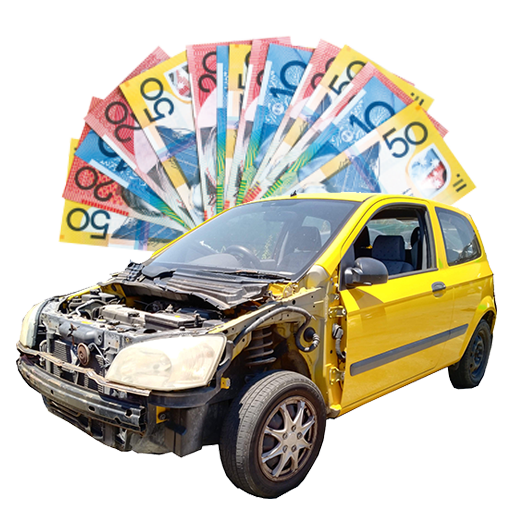When you’re ready to get rid of an old car, the first thing on your mind is probably, “How much cash can I actually get for it?” It’s the million-dollar question, isn’t it?
The truth is, the payout from a wrecker in Adelaide can swing wildly. You might get as little as $150 for a rusted-out shell, or you could see an offer well over $10,000 for a newer, in-demand model that’s been written off. It all comes down to your car’s specific make, model, and what state it’s in.
So, What Do Wreckers Actually Pay for Cars?
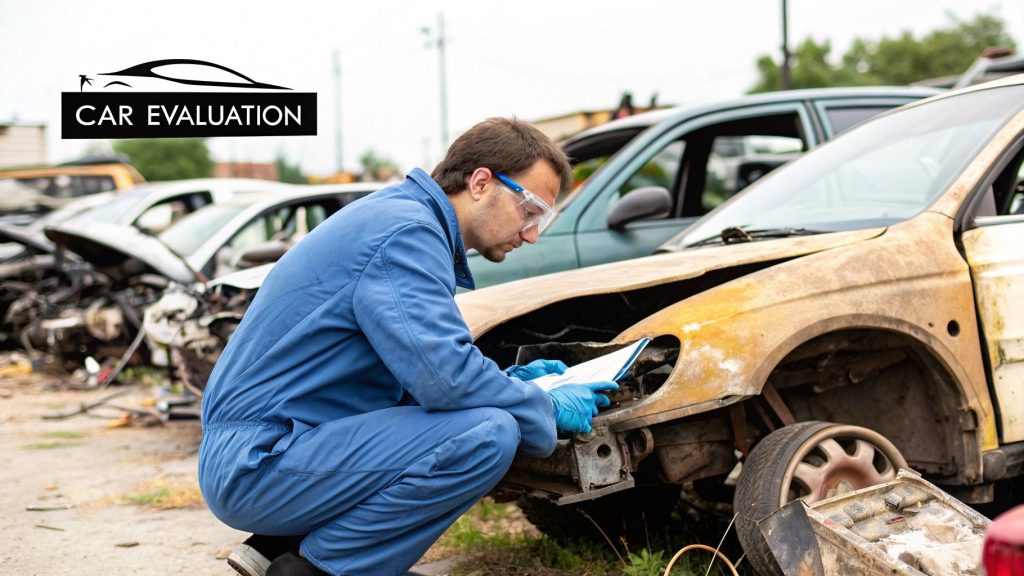
The best way to understand a wrecker’s offer is to stop thinking of your vehicle as a car and start seeing it for what they see: a collection of valuable resources. To a car wrecker, your old sedan or ute isn’t just a single item. It’s an inventory of parts they can resell and a big pile of scrap metal.
This shift in perspective is everything. The quote you receive isn’t some random number they’ve pulled out of thin air. It’s a careful calculation based on the profit they can turn from all the individual bits and pieces of your vehicle.
A Breakdown of Payout Brackets
To get a realistic idea of what your car might be worth, it’s helpful to see where it fits on the value spectrum. The condition of your vehicle is the single biggest factor.
Here’s a general guide to help set your expectations:
- End-of-Life & Scrap Cars ($150 – $500): We’re talking about cars that are non-runners, badly damaged, or just plain ancient. At this stage, their value is almost entirely based on their weight in scrap metal.
- Older but Complete Cars ($400 – $1,500): Think of a car from the early 2000s that still has a working engine and transmission, even if other things are wrong with it. Its key mechanical parts still have a good bit of life left in them for someone else’s repair job.
- Damaged Late-Model Cars ($1,500 – $10,000+): This is where you’ll find newer vehicles that have been in a prang. They might be written off, but they’re packed with valuable, undamaged components like modern engines, infotainment systems, airbags, and pristine body panels.
A wrecker’s business model is built on salvaging and reselling parts. A common, popular vehicle like a Toyota Hilux or a Mazda 3 will nearly always command a better price than a rare European import. Why? Because the demand for their parts is huge right across Australia.
Getting your head around these brackets gives you a much clearer picture. The more high-demand, salvageable parts your car has, the more its value climbs beyond the simple price of scrap steel.
Estimated Payouts from Wreckers by Car Condition
To give you an even clearer idea, this table breaks down some typical payout ranges based on a vehicle’s general condition and type. Think of it as a rough guide to what you might be offered.
| Car Condition | Vehicle Type Example | Estimated Payout Range (AUD) |
|---|---|---|
| End-of-Life / Scrap | 1995 Holden Commodore (non-running, rusted) | $150 – $500 |
| Older but Complete | 2004 Toyota Corolla (running but needs work) | $400 – $1,500 |
| Damaged Late-Model | 2018 Mazda CX-5 (front-end damage) | $1,500 – $10,000+ |
| High-Demand Ute/4×4 | 2012 Toyota Hilux (mechanically sound, body damage) | $2,000 – $9,000+ |
Remember, these figures are estimates. Your final offer will always depend on a direct inspection and the current market demand for your specific car’s parts. A sought-after engine or a set of clean alloy wheels can easily push your offer into the higher end of the range.
The Key Factors That Determine Your Car’s Value
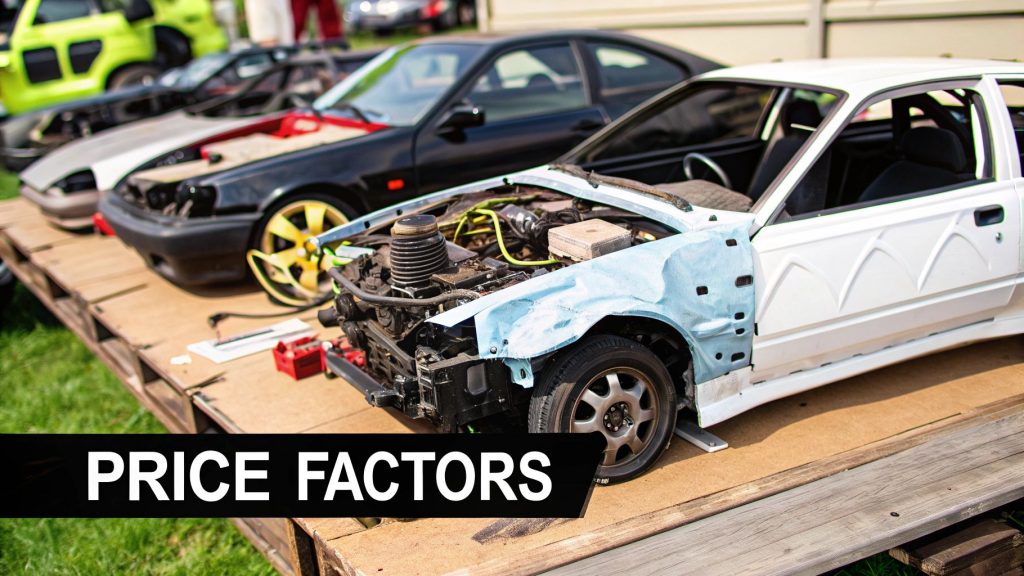
Ever wondered why one old clunker might fetch a quick $200 while a similar-looking one gets a $2,000 offer? The secret isn’t just about looks; it’s about a specific set of factors that wreckers use to calculate exactly what your car is worth to them.
Seeing your car through their eyes is the key to understanding its real value. It all boils down to a few core things: the make and model, its age, and how much of the car is actually still there.
Make, Model, and Age
This is the starting block for any valuation. A super common car on Adelaide’s roads, like a Toyota Camry or Mazda CX-5, is almost always going to be worth more to a wrecker than a rare European import. Why? It’s simple supply and demand.
More popular models mean more people are out there looking for affordable, secondhand parts to keep their own cars running. It’s no secret that Australia’s car fleet is getting on a bit—the average passenger vehicle is now over 10 years old. This creates a steady, reliable market for used parts.
While newer brands like BYD and MG are popping up everywhere, it’ll take time for a strong secondhand parts market to build around them. For now, the old favourites rule the roost.
Key Takeaway: The more common your car’s make and model, the higher the demand for its parts. This almost always translates into a better cash offer for you.
Condition and Completeness
Next up is the car’s overall state. And no, this doesn’t just mean “does it start?”. A professional wrecker is looking much deeper, assessing the condition of individual, high-value components that they can salvage and sell.
Here’s what they’re really looking for:
- Engine and Transmission: These are the big-ticket items. If they’re still in good working order, your car’s value gets a serious bump.
- Body Panels: Doors, bonnets, and guards without major dents or rust are easy to resell to someone who’s had a minor bingle.
- Interior Components: Things like seats, dashboards, and infotainment systems, especially from later models, are often in high demand.
A vehicle that is complete—meaning it still has its engine, transmission, catalytic converter, and all its wheels—is always worth more than a stripped-out shell. Every major part that’s missing is a piece of profit the wrecker can’t recover.
For more insider tips, check out our guide on how to get the best deal when selling your car for cash.
How Market Trends and Technology Influence Wrecker Payouts
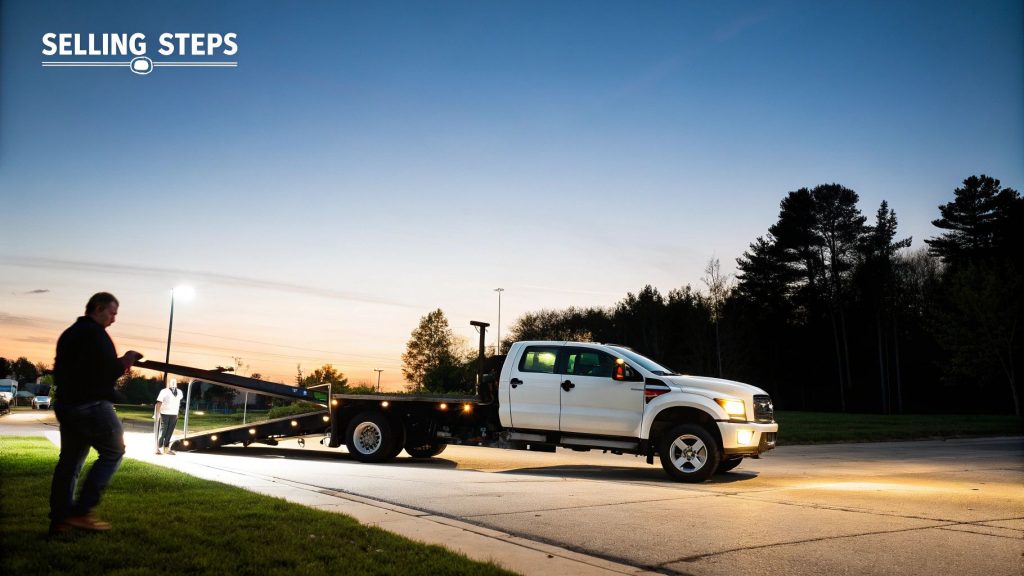
When a wrecker hands you a quote, it’s not just a reflection of your car’s condition. That figure is also shaped by powerful economic forces happening far beyond your driveway. Think of scrap metal prices like a stock market – they’re constantly shifting based on global supply and demand.
This means the exact same car could fetch a different price from one month to the next. A large chunk of a wrecker’s profit comes from the raw metal, so when global demand for steel rises (say, from a construction boom overseas), scrap prices climb, and that translates into a better offer for you. A global slowdown, on the other hand, can cool prices down.
The Role of Used Car Market Dynamics
The health of the wider used car market has a surprisingly direct impact on your payout. When secondhand cars are flying off the lots at high prices, many people decide it’s cheaper to repair their current vehicle rather than replace it. This creates a huge demand for quality, affordable parts from wreckers.
Because of this, a wrecker might offer you a premium for your unwanted car. They know they can quickly sell its alternator, gearbox, or door panels to people trying to keep their own cars running. But if the used market is flooded and prices are dropping, the demand for recycled parts can soften, and that will likely be reflected in a lower offer.
Your car’s value to a wrecker is a direct reflection of current market needs. It’s not just a static price tag but a dynamic figure influenced by local and global economies.
How Modern Technology Shapes Your Offer
The old image of a dusty yard where parts are just piled high is long gone. Today’s auto-wrecking industry is a lot smarter and more connected than most people realise, and that technology directly influences your quote.
Wreckers now use sophisticated software to get a laser-accurate valuation of your vehicle. These AI-powered inventory systems can track real-time demand for specific components, not just in Adelaide but right across the country. This data-driven approach means they can make a much more precise offer based on exactly what they know they can sell and for how much.
If you’re keen to learn more, you can explore the future of auto-wrecking in Australia and see how these trends are changing the industry.
Practical Tips to Maximise Your Payout From Wreckers
Knowing what goes into a wrecker’s offer is the first step, but putting that knowledge to work to get more cash in your pocket is where it really counts. With a bit of a strategy, you can genuinely influence the final payout you receive.
First things first, get your paperwork sorted. Having the car’s title or registration certificate on hand shows you’re the legitimate owner and ready to do business. It smooths out the whole process and signals to the buyer that you’re organised and serious.
It also pays to give the car a quick clean. I’m not talking about a full professional detail, but simply clearing out the rubbish and your personal belongings makes a surprisingly big difference. A tidy car is far easier for the wrecker to inspect, helping them see the true condition of valuable interior parts.
Get Multiple Quotes and Be Honest
Your most powerful move? Don’t take the first offer. Always get in touch with at least three different wreckers for a quote. This instantly creates a competitive situation and gives you the upper hand when you negotiate. When a buyer knows you have other options, they’re much more likely to put their best price forward from the get-go.
When you’re describing your car, honesty is the best policy. Be upfront about everything—missing parts, patches of rust, or major mechanical faults. A truthful description gets you a more accurate initial quote, which builds trust and stops the wrecker from slashing their offer when they see the car in person.
Finally, always ask about hidden fees. Some operators might try to chip away at your offer by deducting towing or admin costs. Make sure you confirm that the price you’re quoted is the exact amount of cash you’ll be handed.
For a more comprehensive look at this process, check out our ultimate guide to scrapping a car in Australia for even more detailed strategies.
Choosing the Right Buyer for Your Unwanted Car
When it’s time to say goodbye to an old car, you’ll find that not all buyers are cut from the same cloth. Where you take it can make a real difference to your final payout and how much of a headache the whole process is. Broadly speaking, you have three main options: car wreckers, scrap metal dealers, and specialised cash for cars services. Each one looks at your vehicle through a different lens.
So, how do you pick the right one? It all comes down to understanding what each buyer truly values. Getting this right is the key to maximising your return.
Car Wreckers vs Scrap Dealers vs Cash for Cars Services
To help you decide, let’s break down the key differences between these buyers. Think of this as a quick guide to matching your car with the person who will pay the most for it.
| Buyer Type | Primary Valuation Factor | Best For | Typical Process |
|---|---|---|---|
| Car Wreckers | Value of individual, reusable parts (engine, gearbox, panels). | Cars with sought-after components, even if they don’t run. Popular models are a plus. | Inspection of parts, offer based on part demand, often includes free removal. |
| Scrap Metal Dealers | The sheer weight of the car’s metal (steel, aluminium, etc.). | Completely dead, stripped, rusted-out, or badly damaged cars with no valuable parts. | Weighing the vehicle, payment based on current scrap metal prices per tonne. |
| Cash for Cars Services | Overall condition and convenience. A blend of part value and scrap weight. | People who want the fastest, simplest sale with minimal effort. | Quick quote online or by phone, same-day pickup, handles all paperwork. |
Ultimately, the best choice depends entirely on what you’re selling. A wrecker will see gold in a mechanically faulty but otherwise intact Holden Commodore, whereas a scrap dealer will only see the value in its weight.
And if you’re after pure convenience, a dedicated ‘cash for cars’ service is tough to beat. They act as a one-stop shop, taking care of the quote, paperwork, and towing. If a fast, no-fuss sale is what you’re after, our team at Auto Removal Adelaide is a great starting point for finding out where to get cash for cars in Adelaide for old cars.
How Your Car’s Condition Changes the Game
This is where you need to be strategic. If you’ve got a late-model car that’s been in a bingle but still has a perfectly good engine and interior, a wrecker is almost certainly your best bet. They’ll pay top dollar for those high-demand parts. On the other hand, if you’re dealing with a rusted-out shell that’s been sitting in a paddock for years, a scrap dealer offers the most straightforward value.
Take a look at this chart. It shows just how much condition matters to a wrecker.
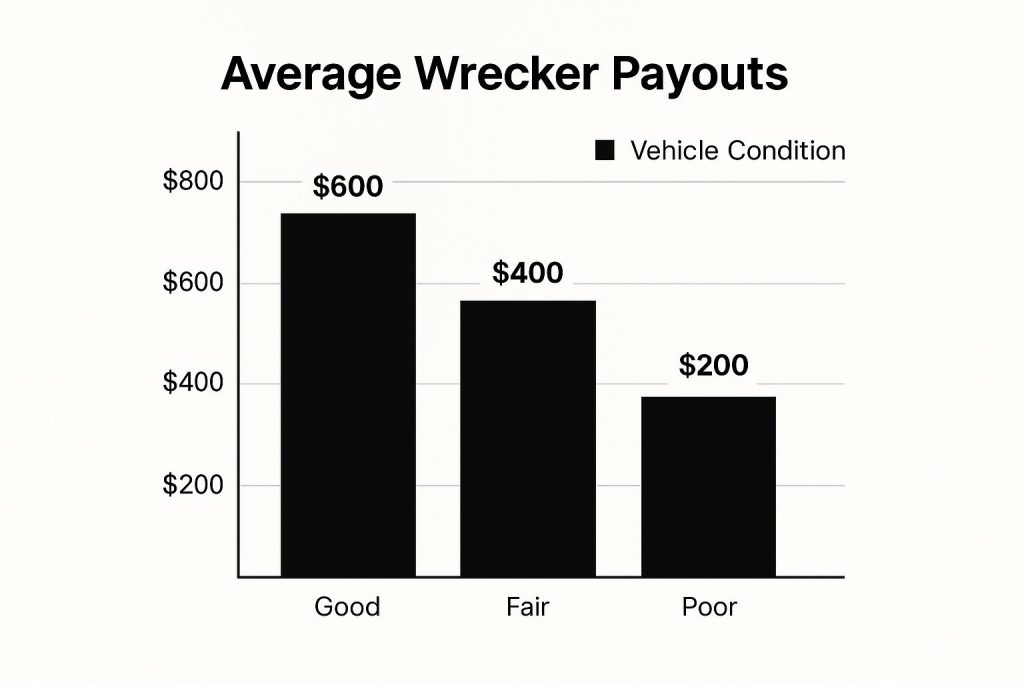
As you can see, the gap between a car in “Poor” condition and one in “Good” condition is massive. This isn’t just about looks; it’s about the number of salvageable, high-value parts a wrecker can pull from it.
Key Insight: Don’t just accept the first offer you get. By understanding how different buyers value your car, you can strategically approach the one who will see the most potential in it—and pay you accordingly.
It’s also worth remembering that the market itself has a huge say. After a strong seller’s market from 2021-2023, things began to shift. Record new car sales in 2024 flooded the market with more vehicles, and by 2025, this softening demand started giving buyers a bit more bargaining power. This often translates to more conservative offers, so timing can play a role in the price you get.
Got Questions? We’ve Got Answers
It’s completely normal to have a few questions swirling around when you’re thinking about selling your old car to a wrecker. After all, it’s not something you do every day.
Let’s clear up some of the most common things people ask us. We want you to feel totally comfortable with the process from start to finish.
Do I Really Need My Rego Papers to Sell My Car?
Yes, you almost certainly will. Any legitimate wrecker in Australia needs to verify that you’re the legal owner before they can hand over any cash. Your registration certificate is the standard way to do this.
Think of it as a safety net for both of us—it prevents any legal headaches later on. If you can’t find your papers, don’t stress. You can usually get a replacement from your local transport authority.
Does a Drivable Car Fetch a Better Price?
Absolutely. A car that can still run and drive usually gets a higher offer. Why? Because it’s a strong signal that the big-ticket items, like the engine and transmission, are in decent shape and can be resold.
It also means the wrecker doesn’t have to factor in the cost and hassle of towing. While a dead car still has value in its parts and scrap metal, one that moves under its own steam is simply worth more.
Keep in mind: The first quote you get online or over the phone is just an estimate based on what you’ve told us. The final, locked-in price comes after we’ve had a quick look at the car in person. Being upfront about its condition is the best way to get an accurate quote and avoid any surprises.
So, What Actually Happens to My Car After It’s Sold?
Your old car is about to start a new life—just in a different form! It enters a well-oiled dismantling process. First, we safely drain all the fluids like oil, petrol, and coolant for proper recycling.
Then, our technicians get to work, carefully removing all the usable parts. Everything from the alternator to the side mirrors is inspected, cleaned, and catalogued for resale to other drivers looking for affordable spares. The final step is for the empty metal shell to be crushed, compacted, and sent off to a recycling plant to be melted down and used to create something new.
Ready to turn that old car into cash in your pocket? At Auto Removal Adelaide, we’re known for giving top-dollar payouts and providing free car removal anywhere in Adelaide. Get your fast, no-obligation quote today.

